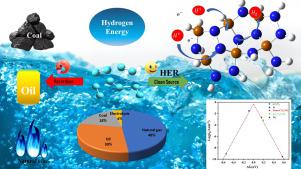当前位置:
X-MOL 学术
›
Int. J. Hydrogen Energy
›
论文详情
Our official English website, www.x-mol.net, welcomes your feedback! (Note: you will need to create a separate account there.)
First-principles study of penta-CN2 quantum dots for efficient Hydrogen Evolution Reaction
International Journal of Hydrogen Energy ( IF 7.2 ) Pub Date : 2024-03-21 , DOI: 10.1016/j.ijhydene.2024.03.016 Rupali Jindal , Rachana Yogi , Alok Shukla
International Journal of Hydrogen Energy ( IF 7.2 ) Pub Date : 2024-03-21 , DOI: 10.1016/j.ijhydene.2024.03.016 Rupali Jindal , Rachana Yogi , Alok Shukla

|
The objective of our research is to investigate the electrocatalytic properties of novel metal-free quantum dots (QDs) composed of the recently discovered 2D material penta-CN, with the aim of replacing costly and scarce catalysts such as Pt and Pd. Employing a first-principles density functional theory (DFT) based approach, the geometries of the three penta-CN quantum dots (QDs) of increasing sizes, 3 × 3, 3 × 4, 4 × 4 are optimized. Through comprehensive analysis, our research extensively explored the structural stability of penta-CN QDs, delved into their electronic properties, and assessed their catalytic performance concerning the Hydrogen Evolution Reaction (HER). Notably, the H-adsorbed penta-CN QDs exhibit a significant reduction in the HOMO-LUMO gap (E) ranging from 35% to 49% compared to the pristine QD. This observation underscores the crucial impact of H-adsorption on Penta-CN QD and is further supported by the appearance of mid-gap states in total and partial density of states plots. Next, we investigated their catalytic performance relevant to HER, using well-known descriptors: (i) adsorption energy, (ii) over-potential, (iii) Gibbs free energy and (iv) exchange current density along with the volcano curve. As far as size dependence of the catalytic performance is concerned, the value of the average change in Gibbs free energy, , is minimum for 3 × 3 penta–CN QD, with those of 3 × 4 and 4 × 4 QDs being slightly larger. Our calculations predict a high value of exchange current density A-cm for one of the sites (N11 for 3 × 3 QD), which we believe will lead to significantly enhanced HER properties. The minimum value of for a 3 3 penta-CN QD implies that its catalytic performance is at least as effective or perhaps better than most of the metal-free hybrid and non-hybrid structures. Our research outcomes hold great promise in advancing the discovery of abundant, non-toxic, and cost-effective catalysts for HER, playing a vital role in facilitating large-scale hydrogen production.
中文翻译:

五CN2量子点高效析氢反应的第一性原理研究
我们研究的目的是研究由最近发现的二维材料五氯化碳组成的新型无金属量子点(QD)的电催化性能,旨在取代昂贵且稀缺的催化剂,例如铂和钯。采用基于第一性原理密度泛函理论 (DFT) 的方法,对尺寸不断增加的三个五氯化碳量子点 (QD) 的几何形状进行了优化,即 3 × 3、3 × 4、4 × 4。通过综合分析,我们的研究广泛探讨了五氯化碳量子点的结构稳定性,深入研究了它们的电子特性,并评估了它们对析氢反应(HER)的催化性能。值得注意的是,与原始 QD 相比,H 吸附的五 CN QD 的 HOMO-LUMO 间隙 (E) 显着降低了 35% 至 49%。这一观察结果强调了氢吸附对 Penta-CN QD 的关键影响,并得到了总态密度和部分态密度图中中能隙态的出现的进一步支持。接下来,我们使用众所周知的描述符研究了它们与 HER 相关的催化性能:(i)吸附能,(ii)过电势,(iii)吉布斯自由能和(iv)沿着火山曲线的交换电流密度。就催化性能的尺寸依赖性而言,3×3 penta-CN QD 的吉布斯自由能平均变化值 最小,3×4 和 4×4 QD 的吉布斯自由能平均变化值稍大。我们的计算预测其中一个位点(3 × 3 QD 的 N11)的交换电流密度 A-cm 值很高,我们相信这将导致 HER 性能显着增强。 3 3 penta-CN QD 的最小值意味着其催化性能至少与大多数无金属杂化和非杂化结构一样有效或可能更好。我们的研究成果对于推进丰富、无毒且经济高效的析氢催化剂的发现具有广阔的前景,在促进大规模制氢方面发挥着至关重要的作用。
更新日期:2024-03-21
中文翻译:

五CN2量子点高效析氢反应的第一性原理研究
我们研究的目的是研究由最近发现的二维材料五氯化碳组成的新型无金属量子点(QD)的电催化性能,旨在取代昂贵且稀缺的催化剂,例如铂和钯。采用基于第一性原理密度泛函理论 (DFT) 的方法,对尺寸不断增加的三个五氯化碳量子点 (QD) 的几何形状进行了优化,即 3 × 3、3 × 4、4 × 4。通过综合分析,我们的研究广泛探讨了五氯化碳量子点的结构稳定性,深入研究了它们的电子特性,并评估了它们对析氢反应(HER)的催化性能。值得注意的是,与原始 QD 相比,H 吸附的五 CN QD 的 HOMO-LUMO 间隙 (E) 显着降低了 35% 至 49%。这一观察结果强调了氢吸附对 Penta-CN QD 的关键影响,并得到了总态密度和部分态密度图中中能隙态的出现的进一步支持。接下来,我们使用众所周知的描述符研究了它们与 HER 相关的催化性能:(i)吸附能,(ii)过电势,(iii)吉布斯自由能和(iv)沿着火山曲线的交换电流密度。就催化性能的尺寸依赖性而言,3×3 penta-CN QD 的吉布斯自由能平均变化值 最小,3×4 和 4×4 QD 的吉布斯自由能平均变化值稍大。我们的计算预测其中一个位点(3 × 3 QD 的 N11)的交换电流密度 A-cm 值很高,我们相信这将导致 HER 性能显着增强。 3 3 penta-CN QD 的最小值意味着其催化性能至少与大多数无金属杂化和非杂化结构一样有效或可能更好。我们的研究成果对于推进丰富、无毒且经济高效的析氢催化剂的发现具有广阔的前景,在促进大规模制氢方面发挥着至关重要的作用。



























 京公网安备 11010802027423号
京公网安备 11010802027423号